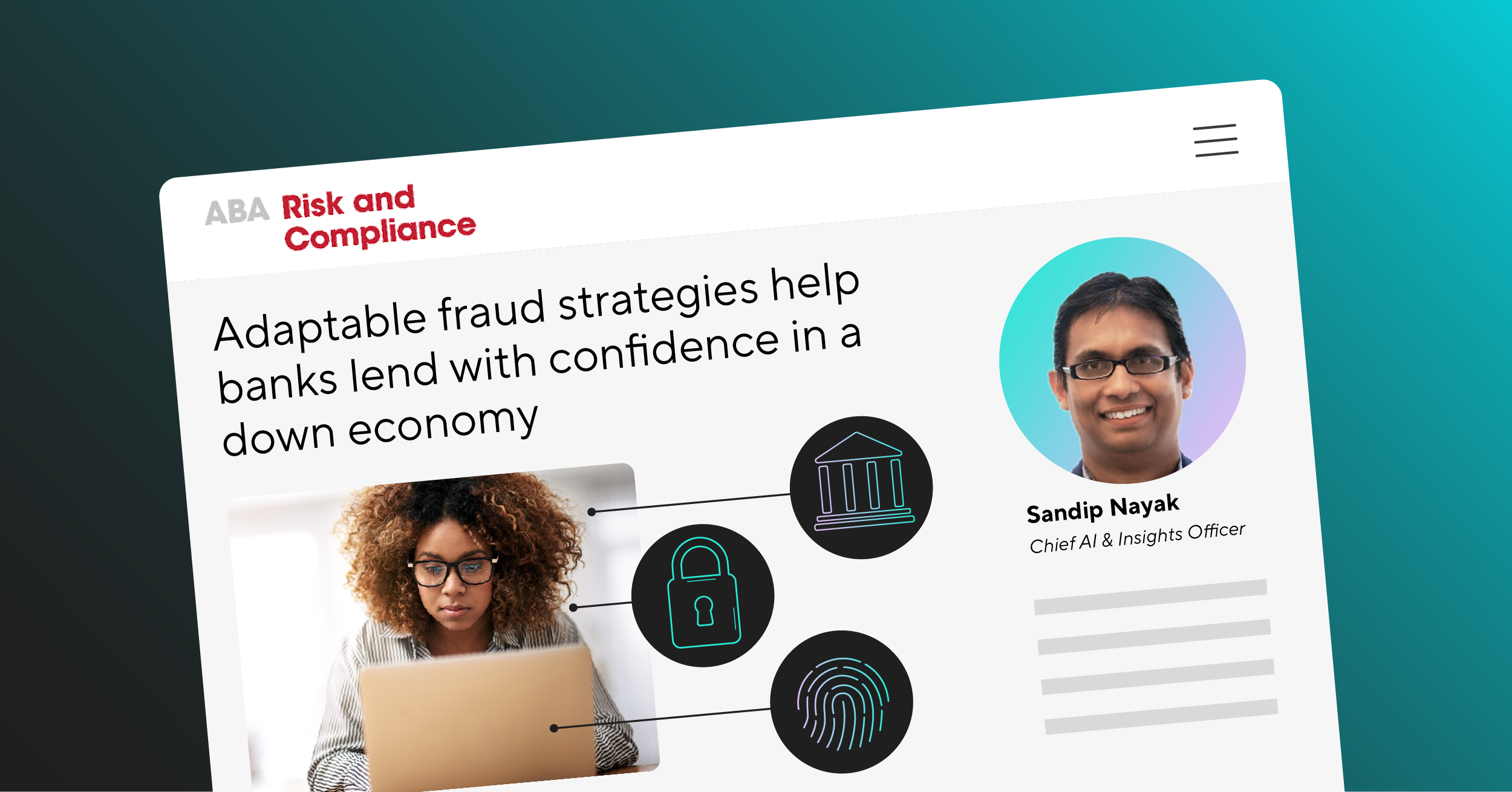Adaptable Fraud Strategies Help Banks and FIs Lend With Confidence in a Down Economy


This is a reprint of an article that originally appeared on ABA Banking Journal on December 29, 2022.
The imminent economic downturn, 'precession,' recession — whatever you want to call it — is presenting banks with a challenge that many have not faced in well over a decade.
While that's an opportunity for banks to assist existing and new customers in meeting their financial needs, an economic crisis presents its own set of realities that lenders must adjust to. Fraud undoubtedly increases for banks in times of economic uncertainty. When businesses and consumers face economic pressure, some of them seek to defraud the system via scams or other nefarious methods. It's the nature of the beast.
Conventional wisdom suggests banks "plug the leaks" in their systems to fight against fraud attempts that happen across the different products, whether it's credit cards, personal loans or small business loans. The folly in that approach, however, is that potential customers with good credit profiles often give up on the account-opening process because they are stymied by excessive fraud checks. Banks miss potential revenue as a result. To improve this customer journey, banks may wish to consider implementing a more adaptable fraud strategy, one that combines both advanced data driven technologies and customer experience as part of the value proposition for lenders to continue offering multiple lending products, even in a time of economic uncertainty.
Fraud prevention in a down economy
One thing I've heard loud and clear from banks over the last several weeks is that when the economy turns or there are signs of stress in the portfolio, executives want to mitigate the fraud risk for their lending products as quickly as possible.
What stops banks from embracing this approach is most of their current processes are archaic. A majority of fraud mitigation systems are heavily rules-based, requiring manual intervention at any sign of trouble. That can lead banks to take weeks to stop a fraud rings, for example, which can cost millions of dollars of lost revenue in the process.
In tandem with current economic uncertainty, banks in general are fighting against more fraud attempts now than they were pre-pandemic. In 2021, banks experienced the highest volume of monthly fraud attacks than they had experienced in previous years, according to a recent study from LexisNexis Risk Solutions. That fraud costs financial institutions $4 of repair for every $1 of fraudulent activity committed, which is up from $3.64 in 2020.
And when there is a soft recession, a subset of consumers and small businesses will seek to defraud the system. Banks, in turn, must create more sophisticated defenses in their lending platforms to mitigate these attempts. Lenders need to navigate these issues intelligently, and the best way to do this is implement a nimbler platform with more sophisticated fraud defenses.
Balancing protection while seizing opportunity
While reinforcing their defenses, banks must not only stay on top of identifying new risks — and developing the underlying strategies to deal with them — but also stay ahead of new opportunities to expand new applicants to the pipeline.
Many signs point to the fact that despite the economy heading towards a downturn, banks can't afford to let their acquisition and retention strategy fall by the wayside.
Small business banking, for example, is an area where banks might be tempted to pull back, especially as government-sponsored small business stimulus programs spurred by the pandemic begin to wind down. Research suggests, however, that doing so could leave opportunity on the table. First Citizens' Bank's survey of small business owners have found that now only 42 percent were optimistic about the economy, but 80 percent said they were confident in their ability to expand their businesses in the next year. This is new business potential that banks should seek to capitalize on.
On the retail side, demand for credit remains high. Inflation has certainly had its major impact, but it appears that between record employment levels and rising wages, there are many resilient potential customers out there presenting an opportunity for the banks who are able to attract and retain them.
An adaptable fraud strategy
To service credit-worthy prospects while also protecting themselves from bad actors, banks should seek to implement an adaptable fraud strategy that prioritizes a smooth customer experience while also protecting the financial institution. Such a platform combines automation, an abundance of data sources, and artificial intelligence/machine learning. This winning combination is effective for the digital/online channels, where the most fraud is happening.
The platform leans on automation and intelligent insights to provide a customer experience that is self-service and low friction, while giving the bank the protection it needs to fend off bad actors. For example, the ideal scenario is to create automated methods in the account-opening process and introduce a bit of friction should a piece of customer information (or lack thereof) trigger a fraud alert. An artificial intelligence/machine learning driven approach can be a key differentiator.
Another key layer of the platform is leveraging intelligence to learn different patterns and behaviors and ultimately fine-tune performance, such as giving banks insight into a loan application and even offering recommendations. For example, an intelligent platform can recommend a loan size amount for a customer based on certain information. That same technology also can identify potential fraud and implement friction into the application process, in a completely automated manner. This strategy opens up opportunities to attract a wider pool of customers, notably prime consumers who banks often overlook or can't evaluate properly. This becomes increasingly vital in a turbulent economy.
In a recession, you want to treat your good customers well because they're the ones contributing to the bottom line. A bad customer experience, combined with chunky delays caused by manual processes, impacts a bank's ability to attract and retain quality customers.
As banks naturally evaluate their current fraud strategies, the end goal for success should be a combination of a great customer journey experience while keeping the institution's best interests in mind.
This moment is a pivotal opportunity for banks' strategies. While investing time and energy into implementing sophisticated fraud defenses and better customer experience may seem like a strategic luxury amidst the sharp focus on the bottom line, this forward-thinking strategy will ultimately help them future-proof against the longer-term economic ebbs and flows. By reducing the rising risk (and expense) of fraud, while winning — and maintaining — the qualified customers who will sustain ongoing opportunity for revenue growth.

To learn more about how AI can protect — and propel — financial services, watch Sandip's interview with PYMNTS.com
 Watch interview
Watch interview